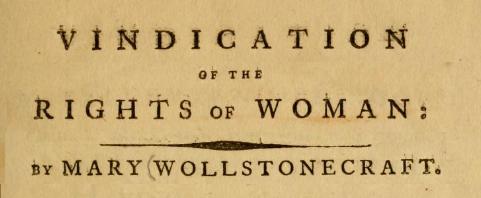And many very happy Free For All birthday wishes to writer, philosopher, and feminist Mary Wollstonecraft!
Wollstonecraft was born on this day in 1759. Though her writing career was a comparatively short one (it is assumed she died of sepsis following the birth of her second child, Mary, at the age of 38), her career was an illustrious one. She wrote novels, philosophical and political treatises, a travel narrative, a history of the French Revolution, a conduct book, and a children’s book. But, by far, her most famous work was A Vindication on the Rights of Women. In this seminal publication, Wollstonecraft essentially argued that men and women were born as, and meant to be equals, but that society, by refusing to educate women’s brains and care for their bodies properly, were forcing women into a subservient role, and ensuring that they would never be anything more than a pretty face.
Mary herself survived an upbringing in an abusive household, striking out on her own at the age of nineteen after her father squandered her inheritance on speculative deals and alcohol. Though a successful and respected teacher, Wollstonecraft nevertheless took the enormous social and financial risk of leaving her teaching position to become a writer–a highly exception choice for women at the time. She eventually moved to France and, in 1792, penned A Vindication on the Rights of Women, which served as a follow-up to her 1790 pamphlet A Vindication on the Rights of Man. In this seminal work, she argued that “females…are made women…when they are mere children”, meaning that girls were taught from a very young age that their only worth lay in physically attracting a man. The result was that women were forced to remain like children for the rest of their lives. It was not their natural inclination to be so, but the way in which they were brought up:
False notions of beauty and delicacy stop the growth of their limbs and produce a sickly soreness…and thus weakened …how can they attain the vigour necessary to enable them to throw off their factitious character?—where find strength to recur to reason and rise superiour to a system of oppression, that blasts the fair promises of spring? This cruel association of ideas, which every thing conspires to twist into all their habits of thinking, or, to speak with more precision, of feeling, receives new force when they begin to act a little for themselves; for they then perceive that it is only through their address to excite emotions in men, that pleasure and power are to be obtained. Besides, the books professedly written for their instruction, which make the first impression on their minds, all inculcate the same opinions. Educated then in worse than Egyptian bondage, it is unreasonable, as well as cruel, to upbraid them with faults that can scarcely be avoided…when nothing could be more natural, considering the education they receive, and that their ‘highest praise is to obey, unargued’—the will of man.
This is not to say that Wollstonecraft’s work was and remains utterly unassailable–A Vindication on the Rights of Women is full of class and gender assumptions, many the result of religion, that date the work considerably. But her argument for the absolute equality of human beings remains a remarkable and moving statement that, largely, is still relevant today.
In you are interested in Mary Wollstonecraft’s legacy, check out the Mary On The Green campaign, which is working to promote Wollstonecraft’s legacy, and to erect a statue in commemoration of her life in London.
More locally, our Library has a wealth of new books that you can check out this weekend–here are a few of the titles that have sauntered on to our shelves this week:

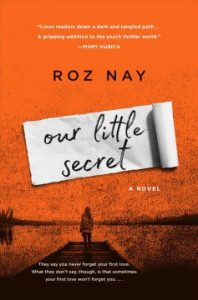 Our Little Secret: The summer thriller season is upon us, and Roz Nay’s debut is an early smash hit. Angela Petitjean is the focus os a police investigation, focused on the disappearance of the wife of Angela’s high school sweetheart, HP. She has vanished. The detective in charge of the case is convinced that Angela has the answers that will solve the case. But Angela has a different story to tell. It began more than a decade ago when she and HP met in high school in Cove, Vermont. She was an awkward, shy teenager. He was a popular athlete. They became friends, fell in love, and dated senior year. Everything changed when Angela went to college. When time and distance separated them, and when Saskia entered the picture. That was eight years ago. HP foolishly married a drama queen and Angela moved on with her life. Whatever marital rift caused Saskia to leave her husband has nothing to do with Angela. Nothing at all. Detective Novak needs to stop asking questions and listen to what Angela is telling him. And once he understands everything, he’ll have the truth he so desperately wants…This is a psychological thriller that will appeal to fans of Paula Hawkins and Ruth Ware. Kirkus Reviews loved this book, calling it a “mesmerizing debut…Nay expertly spins an insidious, clever web, perfectly capturing the soaring heights and crushing lows of first love and how the loss of that love can make even the sanest people a little crazy. Carve out some time for this riveting, one-sitting read.”
Our Little Secret: The summer thriller season is upon us, and Roz Nay’s debut is an early smash hit. Angela Petitjean is the focus os a police investigation, focused on the disappearance of the wife of Angela’s high school sweetheart, HP. She has vanished. The detective in charge of the case is convinced that Angela has the answers that will solve the case. But Angela has a different story to tell. It began more than a decade ago when she and HP met in high school in Cove, Vermont. She was an awkward, shy teenager. He was a popular athlete. They became friends, fell in love, and dated senior year. Everything changed when Angela went to college. When time and distance separated them, and when Saskia entered the picture. That was eight years ago. HP foolishly married a drama queen and Angela moved on with her life. Whatever marital rift caused Saskia to leave her husband has nothing to do with Angela. Nothing at all. Detective Novak needs to stop asking questions and listen to what Angela is telling him. And once he understands everything, he’ll have the truth he so desperately wants…This is a psychological thriller that will appeal to fans of Paula Hawkins and Ruth Ware. Kirkus Reviews loved this book, calling it a “mesmerizing debut…Nay expertly spins an insidious, clever web, perfectly capturing the soaring heights and crushing lows of first love and how the loss of that love can make even the sanest people a little crazy. Carve out some time for this riveting, one-sitting read.”
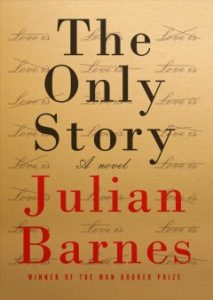 The Only Story: Julian Barnes manages to cross genres with apparent ease, moving from success to success–now, this contemporary love story already is being hailed on several ‘best of’ lists. One summer in the sixties, in a staid suburb south of London, Paul comes home from university, aged nineteen, and is urged by his mother to join the tennis club. In the mixed-doubles tournament he’s partnered with Susan Macleod, a fine player who’s forty-eight, confident, ironic, and married, with two nearly adult daughters. She is also a warm companion, their bond immediate. And they soon, inevitably, are lovers. Clinging to each other as though their lives depend on it, they then set up house in London to escape his parents and the abusive Mr. Mcleod. Decades later, Paul looks back at how they fell in love, how he freed Susan from a sterile marriage, and how–gradually, relentlessly–everything fell apart, and he found himself struggling to understand the intricacy and depth of the human heart. Publisher’s Weekly wrote a heartfelt review of this book, noting “[This] deeply touching novel is a study of heartbreak. . . . By revisiting the flow and ebb of one man’s passion, Barnes eloquently illuminates the connection between an old man and his younger self.”
The Only Story: Julian Barnes manages to cross genres with apparent ease, moving from success to success–now, this contemporary love story already is being hailed on several ‘best of’ lists. One summer in the sixties, in a staid suburb south of London, Paul comes home from university, aged nineteen, and is urged by his mother to join the tennis club. In the mixed-doubles tournament he’s partnered with Susan Macleod, a fine player who’s forty-eight, confident, ironic, and married, with two nearly adult daughters. She is also a warm companion, their bond immediate. And they soon, inevitably, are lovers. Clinging to each other as though their lives depend on it, they then set up house in London to escape his parents and the abusive Mr. Mcleod. Decades later, Paul looks back at how they fell in love, how he freed Susan from a sterile marriage, and how–gradually, relentlessly–everything fell apart, and he found himself struggling to understand the intricacy and depth of the human heart. Publisher’s Weekly wrote a heartfelt review of this book, noting “[This] deeply touching novel is a study of heartbreak. . . . By revisiting the flow and ebb of one man’s passion, Barnes eloquently illuminates the connection between an old man and his younger self.”
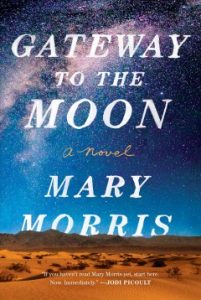 Gateway to the Moon: Mary Morris’ latest novel is a fascinating historical investigation and a contemporary study of how the scars of the past can persistently effect the present. In 1492, the Jewish and Muslim populations of Spain were expelled, and Columbus set sail for America. Luis de Torres, a Spanish Jew, accompanies Columbus as his interpreter. His journey is only the beginning of a long migration, across many generations. Over the centuries, de Torres’ descendants travel from Spain and Portugal to Mexico, finally settling in the hills of New Mexico. Five hundred years later, it is in these same hills that Miguel Torres, a young amateur astronomer, finds himself trying to understand the mystery that surrounds him and the town he grew up in. Entrada de la Luna is a place that holds a profound secret–one that its residents cannot even imagine. It is also a place that ambitious children, such as Miguel, try to leave. Poor health, broken marriages, and poverty are the norm. Luck is unusual. When Miguel sees a flyer for a babysitting job, he jumps at the opportunity, and begins work for a Jewish family new to the area. Interwoven throughout the present-day narrative are the powerful stories of the ancestors of Entrada’s residents, highlighting the torture, pursuit, and resistance of the Jewish people. This is another compelling work that earned a starred review from Booklist, who described it as “[An] enthralling saga . . . The story glides effortlessly between viewpoints and vibrant settings ranging from Lisbon to Tangiers, the Caribbean, and Mexico City. With prose as clear as the star-strewn night sky, Morris’ novel explores people’s hidden connections.”
Gateway to the Moon: Mary Morris’ latest novel is a fascinating historical investigation and a contemporary study of how the scars of the past can persistently effect the present. In 1492, the Jewish and Muslim populations of Spain were expelled, and Columbus set sail for America. Luis de Torres, a Spanish Jew, accompanies Columbus as his interpreter. His journey is only the beginning of a long migration, across many generations. Over the centuries, de Torres’ descendants travel from Spain and Portugal to Mexico, finally settling in the hills of New Mexico. Five hundred years later, it is in these same hills that Miguel Torres, a young amateur astronomer, finds himself trying to understand the mystery that surrounds him and the town he grew up in. Entrada de la Luna is a place that holds a profound secret–one that its residents cannot even imagine. It is also a place that ambitious children, such as Miguel, try to leave. Poor health, broken marriages, and poverty are the norm. Luck is unusual. When Miguel sees a flyer for a babysitting job, he jumps at the opportunity, and begins work for a Jewish family new to the area. Interwoven throughout the present-day narrative are the powerful stories of the ancestors of Entrada’s residents, highlighting the torture, pursuit, and resistance of the Jewish people. This is another compelling work that earned a starred review from Booklist, who described it as “[An] enthralling saga . . . The story glides effortlessly between viewpoints and vibrant settings ranging from Lisbon to Tangiers, the Caribbean, and Mexico City. With prose as clear as the star-strewn night sky, Morris’ novel explores people’s hidden connections.”
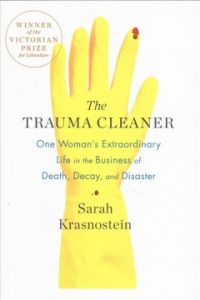 The Trauma Cleaner: One Woman’s Extraordinary Life in the Business of Death, Decay, and Disaster: Sarah Krasnostein’s profile of Sandra Pankhurst is a multi-layered and complex study. Sandra Pankhurst was many things: husband and father, drag queen, gender reassignment patient, sex worker, small businesswoman, trophy wife. But Pankhurst found her calling as a trauma cleaner, going to the places where no one else would go, and providing her patients the care and dignity she was so often denied. But as a little boy, raised in violence and excluded from the family home, she just wanted to belong. Now she believes her clients deserve no less. This is a compelling, humane biography, and a powerful study about the compassionate work of a trauma cleaner. Sarah Krasnostein followed Pankhurst into some of the most horrible of living conditions and watched her bring order and care to both the living and the dead. Her compassion is extraordinary, and this book, though harrowing, is also a moving reminder about the power of an individual in a world of pain. Booklist gave this engrossing study a starred review, noting “Through countless encounters with the fetid, the neglected, and the downright tragic, Parkhurst has found meaning and peace, and [author] Krasnostein a singular subject whom she approaches with well-deserved awe.”
The Trauma Cleaner: One Woman’s Extraordinary Life in the Business of Death, Decay, and Disaster: Sarah Krasnostein’s profile of Sandra Pankhurst is a multi-layered and complex study. Sandra Pankhurst was many things: husband and father, drag queen, gender reassignment patient, sex worker, small businesswoman, trophy wife. But Pankhurst found her calling as a trauma cleaner, going to the places where no one else would go, and providing her patients the care and dignity she was so often denied. But as a little boy, raised in violence and excluded from the family home, she just wanted to belong. Now she believes her clients deserve no less. This is a compelling, humane biography, and a powerful study about the compassionate work of a trauma cleaner. Sarah Krasnostein followed Pankhurst into some of the most horrible of living conditions and watched her bring order and care to both the living and the dead. Her compassion is extraordinary, and this book, though harrowing, is also a moving reminder about the power of an individual in a world of pain. Booklist gave this engrossing study a starred review, noting “Through countless encounters with the fetid, the neglected, and the downright tragic, Parkhurst has found meaning and peace, and [author] Krasnostein a singular subject whom she approaches with well-deserved awe.”
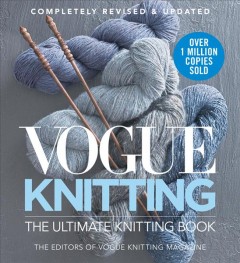 Vogue Knitting: The Ultimate Knitting Book: Anyone with knitterly aspirations, from the novice to the seasoned professional, will find things to learn in this massive and marvelous book. The good people at Vogue Knitting have updated, revised, and expanded their seminal guide to include a new library of stitches, details on hat, shawl, sock, and sweater construction, more than 1,600 photos and hand-drawn step-by-step illustrations. With so many knitting guides, how-to’s, and illustrated help books out there, it’s hard to call any book ‘comprehensive’, but this one comes darned close. With easy-to-read directions, helpful footnotes and cross-references, and oodles of updates, it’s not difficult to see why Library Journal gave this book a starred review and called it “An essential addition to the knitter’s bookshelf.”
Vogue Knitting: The Ultimate Knitting Book: Anyone with knitterly aspirations, from the novice to the seasoned professional, will find things to learn in this massive and marvelous book. The good people at Vogue Knitting have updated, revised, and expanded their seminal guide to include a new library of stitches, details on hat, shawl, sock, and sweater construction, more than 1,600 photos and hand-drawn step-by-step illustrations. With so many knitting guides, how-to’s, and illustrated help books out there, it’s hard to call any book ‘comprehensive’, but this one comes darned close. With easy-to-read directions, helpful footnotes and cross-references, and oodles of updates, it’s not difficult to see why Library Journal gave this book a starred review and called it “An essential addition to the knitter’s bookshelf.”
Until next week, beloved patrons–happy reading!


